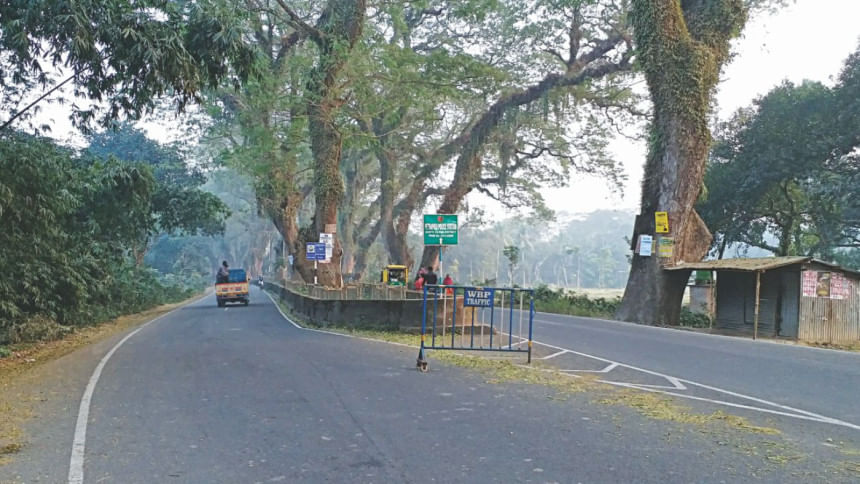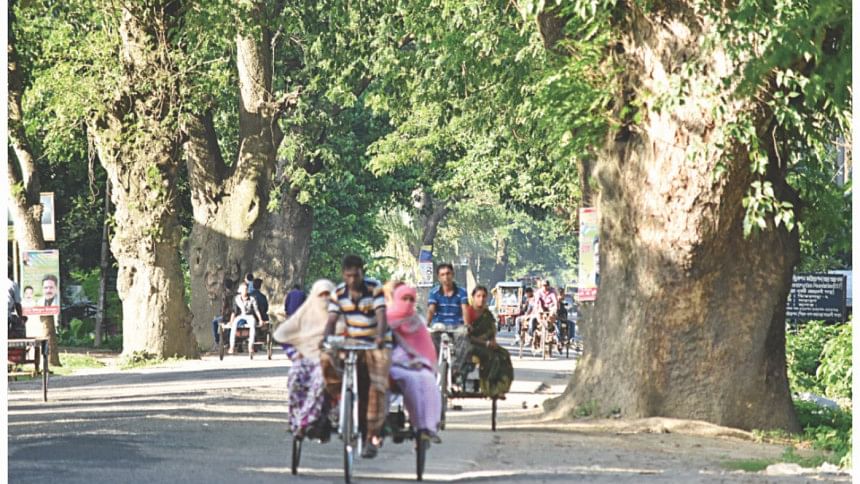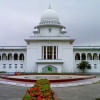ALTERNATIVE IS THERE

Although there is sufficient government land on both sides of Jessore Road, the local authorities seem to be hell-bent on expanding the historical road by felling more than 2,300 trees, several hundred of them nearly two centuries old.
And the justifications the Jessore Roads and Highways Department is offering for cutting these trees are nothing but “lame excuses”, experts and environmentalists have said, warning of an environmental disaster in the region.
On January 6, the RHD in Jessore made the decision to expand the highway to 10.6 metres from 7.3 metres now because of the increasing traffic on the road that connects the country's biggest land port in Benapole with India's Petrapole.
Currently, some 500 goods trucks as well as about 10,000 passengers to and from India use this route. The Benapole Port authorities collect about Tk 12 crore in customs duty every day, said port Director Aminul Islam.
Earlier in July last year, the government shelved a similar plan to fell 2,700 trees for widening the same highway following protests by the public and green activists amid media outcry.
The highway is widely known as a part of around 99km long Jessore Road stretching from Jessore in Bangladesh to Dum Dum in Kolkata.
The stretch on the Bangladesh side is 38km long and 24 feet wide, and on both the south and the north sides of the road there is government land that is at least 50 feet wide, according to the District Council that owns the land of the road.
"So if they build a two-lane road along the existing one next to the trees, we can save these trees," said Amirul Alam Khan, an environmentalist from Jessore.
It is “outright foolish” to fell hundreds of trees, particularly those that bear memories of the Liberation War, just to widen the road by three meters, he added.
The RHD can easily construct a completely new road along the trees on either side of the road to facilitate the growing trade through the road between Bangladesh and India, said Aminul, also former chairman of Jessore Education Board.
The move to fell the trees sparked protests in Dhaka and elsewhere, with green activists asking the government not to take up any project without considering the ecological balance of the area and historic values of the trees.
THE JESSORE ROAD
In 1840, a Jessore landlord called Kali Poddar Babu took the initiative to build the road so that his mother could travel to take a bath in the Ganges river.
Later, as advised by his mother, a lot of saplings were planted on both sides of the road, then named Kali Poddar road, to make people's journeys pleasant ones, according to "Jessore-Khulnar Itihas" (History of Jessore and Khulna), written by Satish Chandra Mitra.
During the 1971 war, tens of thousands of Bangalees fled to India through this road. Freedom fighters and journalists from around the world also used this road to enter Bangladesh from India and the vice versa.
The name of the road has been immortalised by the American poet Allen Ginsberg, who visited the area in 1971 and wrote the famous poem, "September on Jessore Road" about the plight of millions of scared Bangladeshis heading towards India during the war. He recited the poem on November 20, 1971, at Saint George Church, New York.

ALL THE EXCUSES
At the January 6 meeting at the the Jessore District Commissioner's office, three local lawmakers, district administration officials, R&H officials and the district council chairman were present.
Jahangir Alam, executive engineer of Jessore RHD who was present at the meeting, said they sent a proposal to the roads and bridges ministry for the expansion and reconstruction of the road by felling the trees.
“No other option was considered,” said Jahangir
Asked why, he said, "The roots of the trees and the water dripping from the leaves during rain damage the road. So we decided to cut down around 2,300 trees along the road for the sake of development.
"It will take at least one year just for the approval of a new project to build another road along the trees. But the existing road needs immediate repair and it cannot wait any longer.”
Six firms took part in the tender for the Tk 329-crore project in November last, and the tenders were now being evaluated. The construction is likely to begin next month, he said.
Saifuzzaman Pikul, chairman of Jessore District Council, which has a long-standing dispute with the RHD over the ownership of assets along the road, said he too had no objection if trees needed to be felled for the “sake of development”.
As the trees are century old, sometimes their branches fall off, injuring people, he said, adding, "If the government orders us, we have nothing to do but to cut down the trees."

'PLENTY OF SCOPE'
Dr Mohammad Mahfuzur Rahman, a professor of environmental science and technology at Jessore University of Science and Technology, said there was plenty of scope to build a road leaving the rain trees intact, but the authorities were not considering those options.
"They want to cut down the trees," he said, sounding frustrated.
If there is a risk of branches falling, it can be stopped by forest management system, meaning by cutting off the dead or risky branches. And engineers should be able to build roads that will not be affected by the tree roots, he said.
The trees along the highway produce a huge shed, which is nearly one-fourth of that produced by the Sundarbans, he pointed out.
THE INDIAN EXAMPLE
The 61-km stretch of the same road on the Indian side is also called Jessore Road. Running from Kolkata airport to Petrapole border via Barasat, this part too has numerous trees on its both sides.
Last year, the National Highways Authority of India (NHAI) felled 15 of those trees near Bongaon railway station for construction of some flyovers, triggering a huge public protest.
Green activists cited the example of the 2km stretch from Petrapole to Jayantipur on which the NHAI constructed a two-lane road keeping the trees in the middle.
The issue later went to the Calcutta High Court, which on April 17 last year ordered a stay on felling of the trees. The matter is still pending before the court where the next hearing is due today.
[Our Kolkata correspondent Subrata Acharya contributed to the report]

 For all latest news, follow The Daily Star's Google News channel.
For all latest news, follow The Daily Star's Google News channel. 






Comments